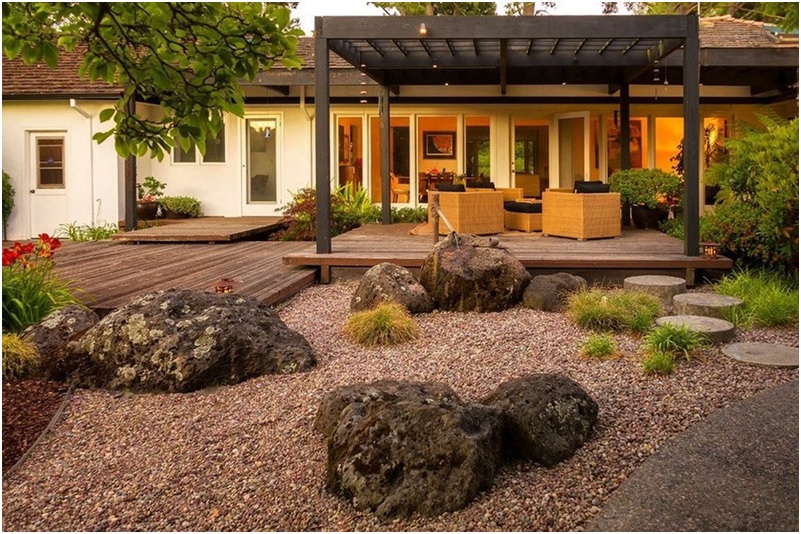The Ultimate Guide to Designing and Maintaining a Rock Garden

Picture yourself strolling down a winding pathway, flanked by abstract and rugged rocks arranged meticulously and harmoniously with vibrant succulent plants. Can you envision the calm and equilibrium that this landscape could instil within your backyard or patio? Have you ever contemplated the art and science behind creating such an iconic rock garden? Often overlooked by conventional gardeners, rock gardens have emerged as a distinctive and elegant feature in the realm of landscape design.
This guide will lead you on a journey of discovery, inviting you to delve deeper than the surface of the canvas. We’ll uncover the layers of these earthy masterpieces, exploring its origins, formation, maintenance, and, most importantly, the ways it can transform the aesthetics of your outdoor space. Ready to explore the bedrock of rock garden design fundamentals? Onward!
Unearthing Origins: The Roots of the Rock Garden Concept
Ever wondered where rock gardens originated? Irrespective of your level of gardening experience, you’ve probably seen or heard of the famed Zen rock gardens of Japan. However, the concept has a richer legacy than its Far East origins (1).
In Tibet and Iran, rock gardens were created not just for aesthetics but primarily as biodiverse refuges, offering a congenial habitat to high-altitude plant species. In the West, their popularity surged in the Victorian era when European mountaineers returned with alpine species, intending to recreate the habitat they thrived in (2).
Artistically, rock gardens also found a niche in the minimalist Japanese Zen gardens, where rocks were used to symbolize aspects of the natural world. They were viewed as an avenue to spiritual enlightenment (3). Interestingly, a single rock garden can contour an entire landscape, demonstrating the unique versatility of this design.
The Crux of Rock Garden Design: Planning and Execution
Planning a rock garden may seem daunting at first, but once you’ve navigated the initial uncertainties, there’s immense aesthetic gratification on the other side.
Firstly, choose the location wisely. While many believe that rock gardens can only thrive in vast spaces, this couldn’t be further from the truth. Even the smallest patio corner or backyard can be transformed into a serene sanctuary brimming with botanical beauty.
Secondly, select the types of rocks and plant species. By considering aspects such as sunlight exposure, drainage quality, native rock, and plant types, you’re setting a firm foundation for a thriving rock garden (4).
Finally, draw a rough sketch outlining the arrangement of rocks and plants. Tailor this vision to mesh with the existing aesthetic of your outdoor space, or to set a fresh, new tone.
The Other Side of the Stone: Pros and Cons of Creating a Rock Garden
Everything comes with a set of advantages and disadvantages, and the art of rock gardening is no exception.
On the bright side, rock gardens are low maintenance, require less water, and provide a habitat for local flora and fauna (5). They’re also an excellent solution for those difficult areas in your property where other plants refuse to grow.
However, on the flip side, rock gardens can be time-consuming and physically demanding to set up. Also, plants that thrive in rock gardens come with their set of challenges. They require unique care and attention, especially during harsh weather conditions.
Cultivating and Preserving: Caring for Your Rock Garden
While rock gardens are generally low maintenance, they aren’t entirely free from care.
Proper watering is a top priority. Water deeply but infrequently to encourage the plant roots to reach deeper into the soil (6). Fertilizers should be applied sparingly, especially to the succulents, which prefer nutrient-poor soil.
Also, note that some rocks retain more heat than others, which can be potentially lethal for your plants. Regular monitoring ensures any issues are promptly identified and addressed before they wreak havoc.
More Than Meets the Eye: The Symbolism and Connection to Nature
Beyond the aesthetics of rock gardens lies a deeper layer of symbolism and a profound connection to nature and our consciousness.
In Zen Buddhism, for example, the stones and gravel in a rock garden symbolize islands and waves, enabling the observer to reflect on the imperfections and transient nature of life (7). Through meticulous planning and creation, the rock garden can become not just a physical, but a metaphysical journey.
In Conclusion: Journeying Through the Rocky Terrain
The allure of blooming roses and green patches has dominated our conventional idea of a garden for a long time. But the world of rock gardens compels us to step out of this comforting familiarity. By seamlessly blending the rustic beauty of rocks with the vibrant colours of succulents and alpine flowers, rock gardens transport us to a world where nature and art meet on a middle ground.
Creating and maintaining a rock garden is a journey strewn with challenges and jubilations. But, armed with the knowledge from this guide, the perils can become stepping stones to an enchanting destination. As your pocket of paradise flourishes and evolves, the gentle whisper of the wind, melodic chirping of the birds, and the harmonic arrangement of stones may just create the perfect symphony for a hushed reflection in your very own backyard sanctuary.